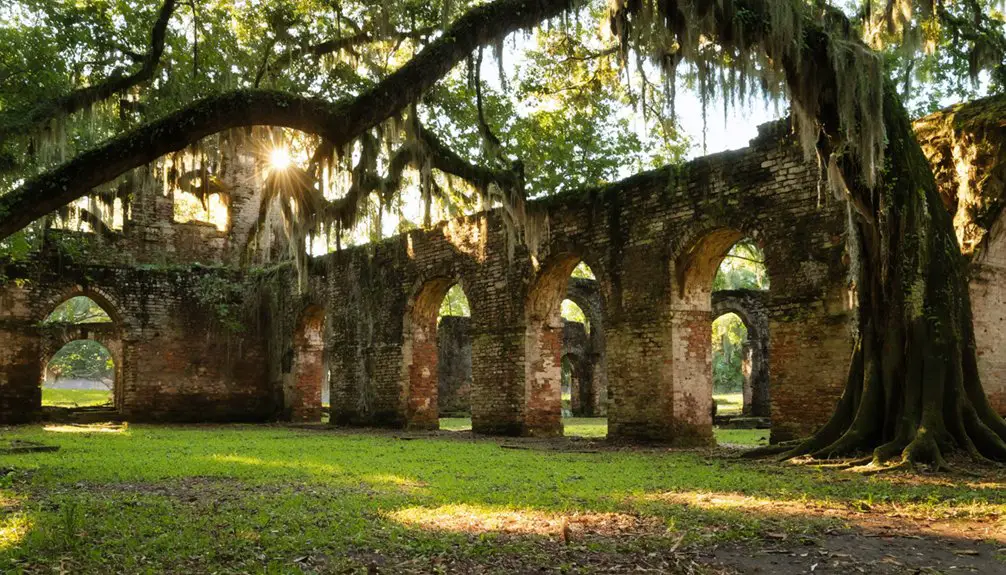You’ll find Portsmouth Village, a fascinating ghost town on North Carolina’s remote Outer Banks, where a once-thriving maritime hub stood. Founded in the mid-1700s, this strategic port community reached its peak with 700 residents before the Civil War changed everything. The last year-round residents left in 1971, but the preserved village still tells tales of maritime life, coastal traditions, and the hardy souls who called this isolated community home.
Key Takeaways
- Portsmouth was a thriving maritime hub in North Carolina’s Outer Banks that became completely abandoned by 1971 when its last permanent residents departed.
- The town’s decline began during the Civil War and accelerated due to economic shifts and the opening of alternative shipping routes.
- Now preserved on the National Register of Historic Places, Portsmouth exists as a ghost town featuring historic maritime architecture and structures.
- The abandoned village spans 250 acres of coastal sanctuary, offering visitors access to untouched beaches, wildlife habitats, and historic buildings.
- Former residents and descendants maintain connections through biannual Homecomings, preserving the town’s cultural heritage and maritime history.
The Rise of a Maritime Hub
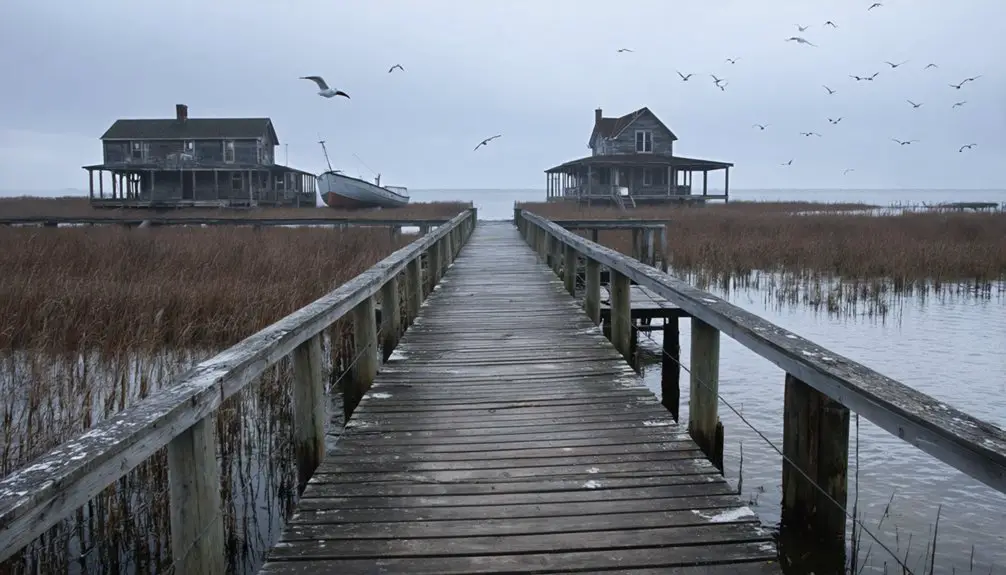
While many colonial settlements along North Carolina’s coast struggled to establish themselves, Portsmouth emerged in the mid-1700s as an important maritime hub due to its strategic location at Ocracoke Inlet.
You’d find this bustling port town serving as a critical transfer point where larger ships had to offload their cargo onto smaller vessels to navigate the shallow inlets.
The maritime economy flourished as Portsmouth developed into the largest settlement on the Outer Banks by 1770, complete with storage facilities and accommodations for merchants and crews.
The town’s position along essential trade routes made it indispensable to North Carolina’s commerce, leading to its evolution as an official commodity inspection port that connected coastal and inland waterways.
Life in Portsmouth’s Golden Era
As Portsmouth’s maritime prominence grew throughout the late 18th and early 19th centuries, daily life in the village took on a distinct character shaped by its seafaring identity.
You’d find nearly 700 residents living a life dictated by the tides and trade, with maritime traditions defining their routines. The post office served as the heart of community gatherings, while boat captains, fishermen, and Life-Saving Station crews kept watch over the bustling waters.
Between the warehouses and piers, you’d spot livestock roaming freely, while locals tended to small gardens that supplemented their seafood-rich diets.
Life flowed between working piers and grazing livestock, as villagers cultivated garden plots to complement their ocean harvest.
The cemetery, with its roughly 40 graves, stood as a reflection of the close-knit nature of this hardworking maritime community.
Civil War’s Lasting Impact
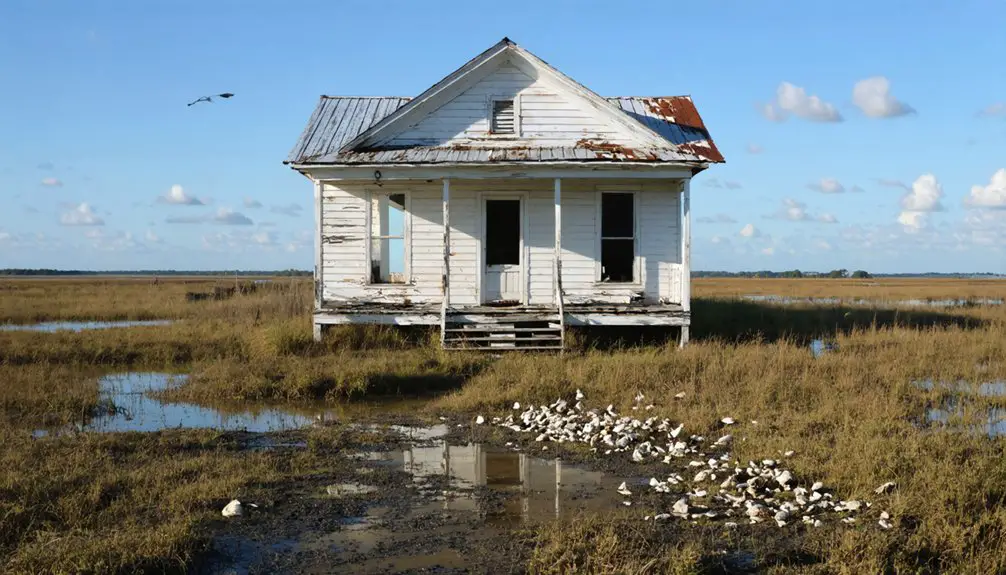
When the Civil War erupted in 1861, Portsmouth’s strategic location along North Carolina’s Outer Banks thrust it into the heart of conflict. You’d find Camp Washington established here before Confederate troops relocated to Fort Hatteras.
As the war intensified, you would’ve witnessed the dramatic decline of this once-bustling port town, where two-thirds of North Carolina’s exports had previously flowed through Ocracoke Inlet.
The Civil War’s impact proved devastating. You’d have seen the Confederate forces destroy fortifications and burn the Navy Yard while retreating, while Lincoln’s naval blockade strangled maritime commerce.
The town’s population of 450 dwindled as residents fled Union incursions. Though Union officers tried encouraging civilians to return, Portsmouth’s glory days were over. The combination of wartime destruction and shifting sandbars sealed the port’s fate.
Decline of a Once-Thriving Community
The devastating aftermath of the Civil War marked the beginning of Portsmouth’s long decline from maritime prominence. Following Union occupation, the population plummeted from 800 to 300 residents, with many families never returning to rebuild their lives on the island.
Despite community resilience, economic shifts proved insurmountable. The opening of Oregon Inlet and deepening of Hatteras Inlet diverted crucial shipping traffic away from Portsmouth’s harbor.
Persistent shoaling further diminished the port’s viability, forcing a shift from prosperous maritime commerce to modest fishing operations. You’d have witnessed the gradual erosion of essential services – the Life-Saving Station’s closure in the 1930s, the school’s shutdown in the mid-1950s, and finally, the post office’s end in 1959.
The Last Residents Say Goodbye

You’ll find the final chapter of Portsmouth’s inhabited history written in 1971, when Marion Babb and Elma Dixon became the last year-round residents to leave the island.
Their departure followed the death of Henry Pigott, marking the end of permanent settlement in this once-bustling coastal community.
While lifetime leases remained active for some families to maintain seasonal connections, the transformation of Portsmouth into a ghost town was now complete.
Final Families Depart 1971
As Portsmouth Island’s population dwindled to just three elderly residents by 1970, the close-knit coastal community faced its final chapter.
Despite their remarkable island resilience, the remaining inhabitants – Elma Dixon, Marian Gray Babb, and Henry Pigott – couldn’t sustain their way of life amid growing community isolation.
When Pigott passed away in 1971, Dixon and Babb made the heart-wrenching decision to leave their beloved homes.
You can still sense their reluctance in the way they left their houses – as if they’d return any day.
Their departure marked the end of continuous habitation since 1752, transforming Portsmouth into a pristine ghost town.
While the island’s buildings stand preserved on the National Register of Historic Places, no permanent residents have called Portsmouth home since that fateful year.
Lifetime Leases Remain Active
Despite Portsmouth’s official abandonment in 1971, many former residents maintained deep connections to their ancestral homes through lifetime lease agreements with the National Park Service. These arrangements provided lifetime security for former property owners while preserving the village’s historic character.
Visitors can see remnants of this history while exploring the 21 remaining buildings that stand as testaments to Portsmouth’s past.
The lifetime leases granted leaseholder rights that include:
- Continued access to and use of their former homes
- Authority to maintain and preserve structures
- Participation in regular homecoming events
- Limited vehicle access privileges for property upkeep
You’ll find these lease agreements carefully balance preservation with personal connection, requiring boat-only access and prohibiting modern utilities.
Through these arrangements, Portsmouth isn’t truly abandoned – it’s actively preserved by those who cherish its heritage, with the National Park Service overseeing both public access and historic conservation efforts.
Preserving Portsmouth’s Legacy
Since the late 1970s, Portsmouth’s legacy has been actively preserved through a combination of federal protection and grassroots efforts.
You’ll find 31 historic structures across 250 acres of protected land, all carefully maintained by the Cape Lookout National Seashore since 1976. The National Register of Historic Places listing in 1978 guarantees these buildings remain safeguarded for future generations.
Historic Portsmouth Village stands preserved across 250 acres, its structures protected as enduring witnesses to America’s coastal heritage.
Cultural preservation thrives through community engagement, particularly with the Friends of Portsmouth Island. Founded in 1989, this volunteer organization hosts biennial homecomings where descendants gather to share stories and songs.
You can participate in cleanup projects, explore educational programs, or join guided tours that bring the village’s maritime history to life. Through these ongoing efforts, Portsmouth isn’t just preserved as a ghost town – it’s maintained as a living symbol of coastal heritage.
Natural Beauty and Coastal Heritage
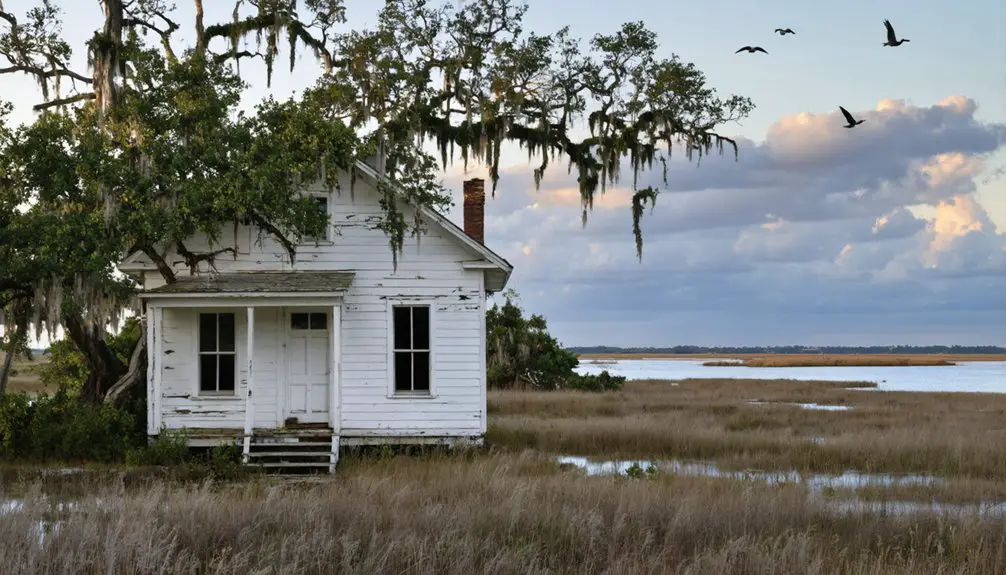
When you visit Portsmouth Island today, you’ll discover a pristine slice of North Carolina’s Outer Banks where sandy lanes wind through 250 acres of untouched coastal wilderness.
You’ll find yourself surrounded by rich marine habitats where shorebirds nest among tidal flats and shellfish beds that have sustained local communities since the 1750s.
The island’s natural beauty perfectly frames its maritime heritage, with historic structures standing as silent sentinels against a backdrop of soundside waters and Atlantic surf that once made Portsmouth a crucial shipping hub.
Pristine Outer Banks Setting
Along the pristine shores of North Carolina’s Outer Banks lies Portsmouth Island, a 250-acre coastal sanctuary that perfectly preserves the region’s natural beauty and maritime heritage.
You’ll discover untouched coastal ecosystems spanning from maritime forests to tidal flats, where nature’s raw beauty remains virtually unchanged since colonial times.
The island’s pristine landscapes offer you:
- Miles of undeveloped beachfront perfect for shell collecting and surf fishing
- Protected tidal flats teeming with native wildlife
- Natural vegetation patterns of salt-tolerant plants and island shrubs
- Unspoiled views of Ocracoke Inlet’s historic waters
Here, you’re free to explore a rare piece of wild Carolina coastline, where historic structures dot the windswept terrain and modern development hasn’t encroached on the island’s authentic Outer Banks character.
Hidden Coastal Wildlife Paradise
Beneath Portsmouth Island‘s untamed exterior lies a remarkable coastal wildlife sanctuary that rivals any natural preserve along the Eastern Seaboard.
You’ll discover massive flocks of brown pelicans, with winter populations reaching 5,000 birds, alongside diverse shorebirds like killdeer and American oystercatchers foraging in grassland puddles.
The island’s rich marine biodiversity includes visiting sea turtles, with loggerheads nesting on summer beaches, while river otters patrol the shoreline.
You’ll find exceptional birdwatching opportunities year-round, especially during spring and fall migrations when myrtle warblers and piping plovers arrive.
The isolated coastal setting supports unique terrestrial species too – from rare rice rats to five-lined racerunner lizards.
This untouched ecosystem creates a perfect haven for wildlife enthusiasts seeking nature in its purest form.
Historic Maritime Environment
Despite its quiet abandonment today, Portsmouth Island’s maritime heritage remains etched into its coastal landscape.
You’ll discover a rich tapestry of coastal ecology where tidal flats, salt marshes, and sandy dunes showcase the dynamic nature of barrier island life.
The maritime architecture of Portsmouth Village, scattered across 250 acres, tells the story of a once-thriving port community.
- The historic marine hospital, built in 1846, stands as a reflection of the island’s essential role in maritime healthcare.
- The 1894 Life-Saving Service station reflects the community’s dedication to seafarer safety.
- Original wharves and storage facilities reveal Portsmouth’s significance as a lightering port.
- The village’s strategic location near Ocracoke Inlet shaped its destiny as an important shipping hub.
Exploring the Ghost Village Today
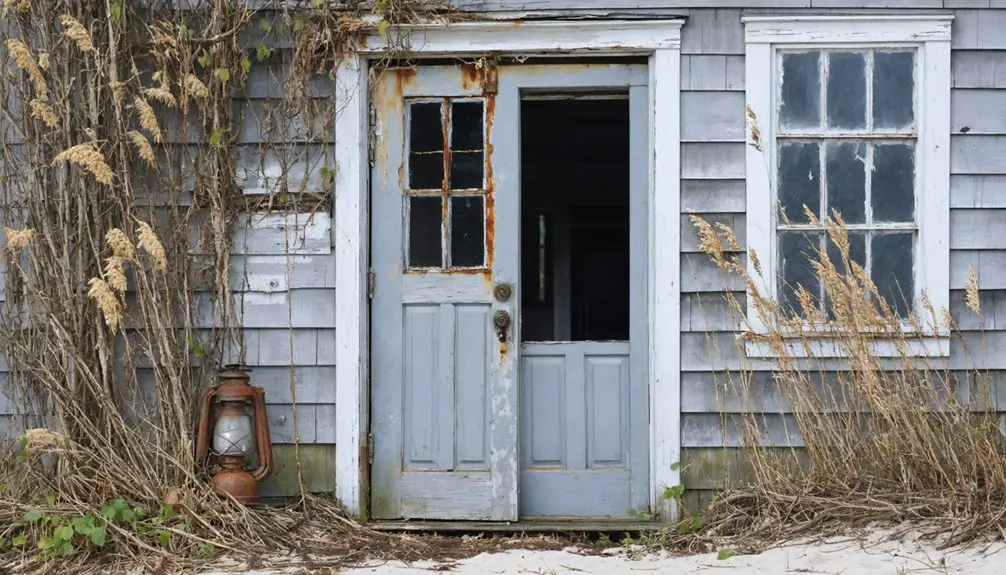
When you visit Portsmouth Island today, you’ll find a hauntingly preserved ghost town spanning roughly 250 acres within Cape Lookout National Seashore. The abandoned structures create a ghostly atmosphere, as if residents simply stepped away from their daily lives.
You can explore the one-room schoolhouse, church, Coast Guard station, and scattered cottages that remain frozen in time. Access requires a boat trip to this 13-mile stretch of pristine coastal wilderness.
Spring and summer offer the best conditions for exploring the historic village, where you’ll discover restored buildings alongside weather-worn ruins. Through guided tours or self-guided walks, you can photograph the architectural remnants and learn about Portsmouth’s evolution from a bustling port to its eventual abandonment in the 1970s.
Stories From Former Residents
The stories of Portsmouth’s former residents paint a vivid portrait of a close-knit maritime community that flourished until 1971. Through oral traditions passed down through generations, you’ll discover tales of resilience against storms, isolation, and economic hardship.
Former residents and their descendants gather during biannual Homecomings to share memories and maintain their deep connection to the island.
These stories reveal their community resilience through:
- Multi-generational fishing and lightering traditions
- Collective response to devastating hurricanes
- Maintenance of essential village institutions
- Strong bonds that persist long after abandonment
Even today, descendants continue visiting their ancestral homes, tending to family cemeteries, and preserving the spirit of Portsmouth through storytelling and preservation efforts.
Their accounts transform this ghost town into a living reflection of maritime heritage.
Frequently Asked Questions
Are There Any Reported Ghost Sightings or Paranormal Activity on Portsmouth Island?
Like a vinyl record skipping through time, you’ll find ghost stories about a 1950s cyclist’s apparition and haunting legends that float through Portsmouth Island’s abandoned buildings.
What Happens to Portsmouth Island During Major Hurricanes and Storm Surges?
You’ll see devastating hurricane damage sweep across Portsmouth Island, with 9-foot storm surges flooding structures, tipping buildings, and carving breaches. Without permanent residents, there’s no storm preparation to protect historic sites.
Can Visitors Stay Overnight on Portsmouth Island?
You can’t find traditional overnight accommodations on Portsmouth Island, but you’re allowed to do primitive camping within Cape Lookout National Seashore boundaries if you bring your own supplies and follow park regulations.
Are Metal Detectors or Artifact Collecting Allowed on Portsmouth Island?
You’ll face hefty fines if caught metal detecting or collecting artifacts on Portsmouth Island – it’s strictly forbidden. Metal detecting regulations and artifact preservation policies protect this National Seashore’s rich historical treasures.
Do Any Original Portsmouth Families Still Own Property on the Island?
No, you won’t find any family ownership on Portsmouth today. All island heritage properties were sold to North Carolina by 1968 and transferred to federal control under Cape Lookout National Seashore by 1976.
References
- https://www.islands.com/1841384/north-carolina-once-bustling-island-village-ghost-town-pristine-beach-coastal-beauty-portsmouth/
- https://www.accuweather.com/en/travel/inside-portsmouth-island-abandoned-ghost-village/931491
- https://www.explore.com/1889250/explore-pristine-coastal-wilderness-unique-north-carolina-ghost-town-portsmouth-island/
- https://www.downeasttour.com/portsmouth
- https://www.youtube.com/watch?v=X7YZLHqzvE0
- https://friendsofportsmouthisland.org/fopi/portsmouth-island-history/
- https://portsvacation.com/portsmouth-history-timeline/
- https://www.portsmouthva.gov/485/Portsmouth-History
- https://www.nps.gov/parkhistory/online_books/calo/portsmouth_village.pdf
- https://en.wikipedia.org/wiki/Portsmouth



